One thing about China is that they are always re-building historical sites. Here are some guys building a new…something…. at the old Ming palace in Nanjing.
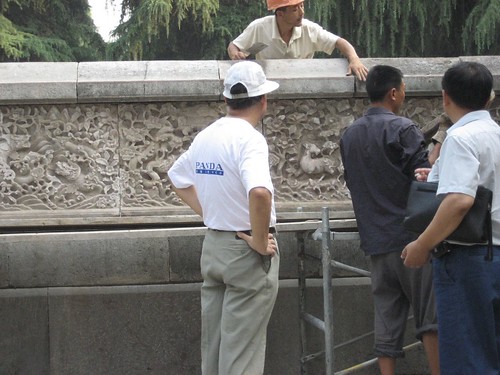
The thing they are making is made out of concrete, and just a generic “traditional” decoration, nothing particularly to do with the site. Much more common in the U.S. is the idea of public history that produces things like this
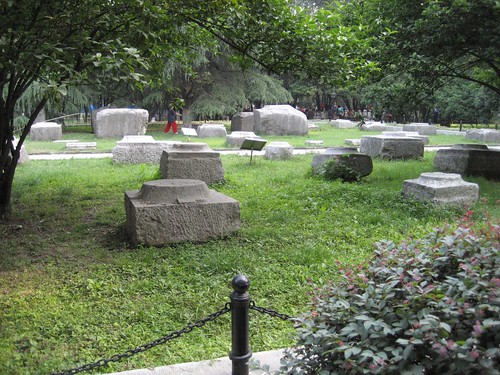
This is also at the old Ming Palace. Just a bunch of rocks found there and set out for you to look at. Just what history has left us and as as “authentic” as possible. This is not to say that things are not re-built, in the West but there is a bias towards leaving things the way they were found, especially at “real” (state-run) historic sites. Complete reconstruction, especially if you don’t know what the old building looked like and are just making it up, is a no-no among public historians. If something is re-built it is always clearly labeled as such, and even regular visitors are disappointed (Aww, it’s just a fake) Colonial Williamsburg is not the goal most sites aim for. The Parthenon still has that big hole in it and probably always will.
How are things different in China? Well, for one thing they seem a bit more daring at re-building. In lots of places things will be patched up, but here, at the Ming Tombs in Nanjing you can see pretty clearly that the entire archway has been re-built from almost nothing. Just the little bit at the bottom is “real” and the rest is modern concrete
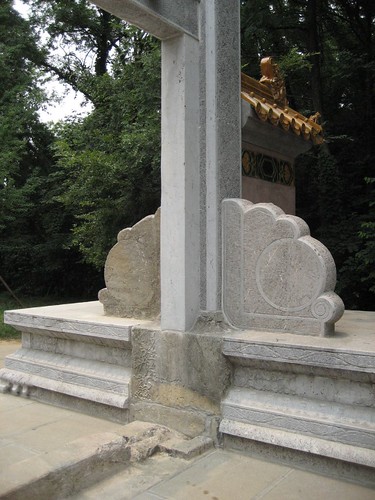
This is the ceremonial arch (Pai lou) outside the Confucian temple in Nanjing.
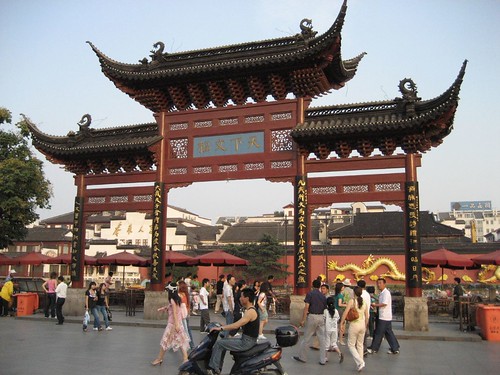
As anyone who has read Craig Clunas or Tobie Myer-Fong knows, many Chinese scenic spots have been re-built over and over again, in may cases hundreds of years after they fell in disrepair. Thus the relationship between the thing you are seeing and the thing that was on the site in the past can be very problematic. Historic sites associated with Buddhism or literati culture or whatever are really just sites on which various people have built various things over the years but the supposed continuity of the site is a myth. Given how much of Chinese architecture is in wood this is not surprising. “This” arch was first built by the Wanli emperor in 1586. It was destroyed and eventually re-built by the Tongzhi emperor in 1869. Tongzhi’s had calligraphy by the famous Cai Duanmu (I assume the first one had calligraphy, but who knows who did it) and it was flanked by two gates. The arch and gates were “removed because of structural decay years later”1 and the current arch was built in 1988 by the People’s government, although it is a little south of the original location, which is now a shopping mall. But still the “same” arch
Another thing that makes historic sites problematic is that lots of things get re-used. Given that the basic design (connected courtyards) of a lot of traditional architecture is the same it was always easy to turn a house into a temple (Like the Lama Temple in Beijing) or a temple into a government office or school. Which of the many uses of the site do you memorialize?

This is the Beamless Hall, again in Nanjing. Originaly it was a Buddhist worship hall for Amitabha, but as they did with so many other Buddhist sites the Nationalists put it to a less feudal use, as a memorial hall to fallen soldiers. Which use is remembered? Well, the plaque outside tells you about the Buddhists, but inside there are dioramas of the Nationalist revolution and of course the names of the fallen. (Hard to remove those.)
And of course many of buildings are sort of composite sites from the start. Many people who built sites seem to have been jackdaws, grabbing elements from all over. This is from the tomb of Tang Yankai, a Nationalist official who died in 1930 and has a large tomb outside Nanjing. It is a peony planter, but it was originally in the Summer Palace at Beijing. Tang seems to have swiped it.
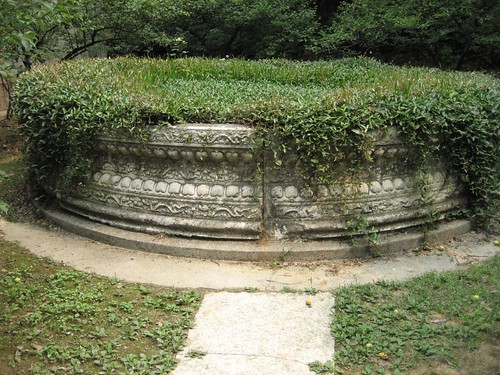
Of course Tang should be careful. This is also at his tomb
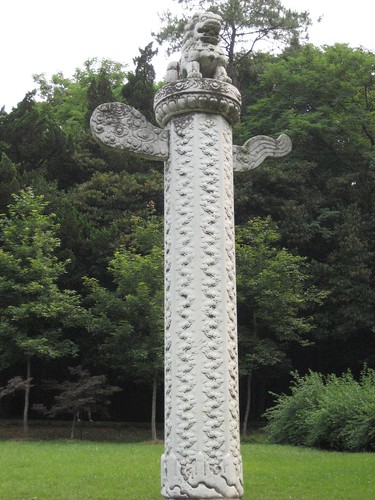
It originally came from the tomb of the Qing official Su Shun, but then some how ended up in the hands of an antique dealer. It was recovered by a Nationalist official, and then presented to Tang’s tomb. If Tang does not watch out bits and pieces of his own tomb might end up in someone else’s. Even as I type there are construction workers there doing something with the site. Not sure what.
which probably means they were destroyed in the Cultural Revolution ↩
Nice pictures and discussion.
To some extent the Chinese method seems more likely to provide some continuity than the American “bulldoze or leave” method in which very little restorative work or recreation is considered acceptable. By Chinese standards, “historic Williamsburg” probably qualifies as a legitimate historical site….
The Japanese, on the other hand, tend to move whole buildings into nice convenient theme parks like Meiji-mura….
Yes, I sort of like the Chinese method myself. Chinese museums, for instance, are much more likely to include copies of famous artifacts or pictures of them to help tell the story. Much better than the Western method of telling the proles they should go to Florence and see the Authentic piece.
My family lives in Australia and is descended from the son of a Ching official who ran away from the threat od punishment in China and sailed on a British ship to Australia in 1862. His father was executed on the orders of Cixi. He was of Manchu/Mongol family and his father was probably Su Shun,
I note references on this website of relics from Su Shun’s tomb, and would like to identify it. We know he was beheaded at the execution grouind in Beijing, but like most high officials his body may have been claimed by his family and buried with honour. We often visit China and Mongolia and would love to know.